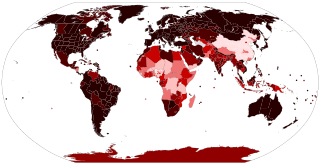
Back Covid-19-pandemie Afrikaans COVID-19-Pandemie ALS 2019-20 ኮሮናቫይረስ ወረርሽኝ Amharic Lifong no kemi AMI Pandemia de COVID-19 AN COFID-19 myċelcoþu ANG جائحة فيروس كورونا Arabic وباء كوڤيد-19 ARZ ক'ভিড-১৯ বৈশ্বিক মহামাৰী Assamese Pandemia de COVID-19 AST
| COVID-19 pandemic | |||||||
|---|---|---|---|---|---|---|---|
 Medical professionals treating a COVID-19 patient in critical condition in an intensive care unit in São Paulo in May 2020 | |||||||
 Confirmed deaths per 100,000 population
as of 20 December 2023 | |||||||
| |||||||
| Disease | Coronavirus disease 2019 (COVID-19) | ||||||
| Virus strain | Severe acute respiratory syndrome coronavirus 2 (SARS‑CoV‑2) | ||||||
| Source | Bats,[1] indirectly[2] | ||||||
| Location | Worldwide | ||||||
| Index case | Wuhan, China 30°37′11″N 114°15′28″E / 30.61972°N 114.25778°E | ||||||
| Dates | Assessed by WHO as pandemic: 11 March 2020 (4 years and 8 months ago)[3]
Public health emergency of international concern: 30 January 2020 – 5 May 2023 (3 years, 3 months and 5 days)[4] | ||||||
| Confirmed cases | 776,798,109[5] (true case count is expected to be much higher[6]) | ||||||
Deaths | 7,074,387[5] (reported) 18.2–33.5 million[7] (estimated) | ||||||
| Fatality rate | As of 10 March 2023: 1.02%[8][needs update] | ||||||
| Part of a series on the |
| COVID-19 pandemic |
|---|
 |
|
|
|
The COVID-19 pandemic (also known as the coronavirus pandemic and COVID pandemic), caused by severe acute respiratory syndrome coronavirus 2 (SARS-CoV-2), began with an outbreak of COVID-19 in Wuhan, China, in December 2019. It spread to other areas of Asia, and then worldwide in early 2020. The World Health Organization (WHO) declared the outbreak a public health emergency of international concern (PHEIC) on 30 January 2020, and assessed the outbreak as having become a pandemic on 11 March.[3]
COVID-19 symptoms range from asymptomatic to deadly, but most commonly include fever, sore throat, nocturnal cough, and fatigue. Transmission of the virus is often through airborne particles. Mutations have produced many strains (variants) with varying degrees of infectivity and virulence.[9] COVID-19 vaccines were developed rapidly and deployed to the general public beginning in December 2020, made available through government and international programs such as COVAX, aiming to provide vaccine equity. Treatments include novel antiviral drugs and symptom control. Common mitigation measures during the public health emergency included travel restrictions, lockdowns, business restrictions and closures, workplace hazard controls, mask mandates, quarantines, testing systems, and contact tracing of the infected.
The pandemic caused severe social and economic disruption around the world, including the largest global recession since the Great Depression.[10] Widespread supply shortages, including food shortages, were caused by supply chain disruptions and panic buying. Reduced human activity led to an unprecedented temporary decrease in pollution. Educational institutions and public areas were partially or fully closed in many jurisdictions, and many events were cancelled or postponed during 2020 and 2021. Telework became much more common for white-collar workers as the pandemic evolved. Misinformation circulated through social media and mass media, and political tensions intensified. The pandemic raised issues of racial and geographic discrimination, health equity, and the balance between public health imperatives and individual rights.
The WHO ended the PHEIC for COVID-19 on 5 May 2023.[4] The disease has continued to circulate, but as of 2024, experts were uncertain as to whether it was still a pandemic.[11][12] Pandemics and their ends are not well-defined, and whether or not one has ended differs according to the definition used.[11][13] As of 17 November 2024, COVID-19 has caused 7,074,387[5] confirmed deaths. The COVID-19 pandemic ranks as the fifth-deadliest pandemic or epidemic in history.
- ^ Zoumpourlis V, Goulielmaki M, Rizos E, Baliou S, Spandidos DA (October 2020). "[Comment] The COVID‑19 pandemic as a scientific and social challenge in the 21st century". Molecular Medicine Reports. 22 (4): 3035–3048. doi:10.3892/mmr.2020.11393. PMC 7453598. PMID 32945405.
- ^ Cite error: The named reference
who-origins-20210330was invoked but never defined (see the help page). - ^ a b Cite error: The named reference
startwas invoked but never defined (see the help page). - ^ a b Cite error: The named reference
reuterswas invoked but never defined (see the help page). - ^ a b c Mathieu E, Ritchie H, Rodés-Guirao L, Appel C, Giattino C, Hasell J, et al. (2020–2024). "Coronavirus Pandemic (COVID-19)". Our World in Data. Retrieved 17 November 2024.
- ^ Mathieu E, Ritchie H, Rodés-Guirao L, Appel C, Giattino C, Hasell J, et al. (5 March 2020). "Coronavirus Pandemic (COVID-19)". Our World in Data. Archived from the original on 24 February 2024. Retrieved 24 February 2024.
- ^ "The pandemic's true death toll". The Economist. 26 July 2023 [18 November 2021]. Archived from the original on 8 February 2024. Retrieved 26 July 2023.
- ^ "COVID-19 Dashboard by the Center for Systems Science and Engineering (CSSE) at Johns Hopkins University (JHU)". ArcGIS. Johns Hopkins University. Retrieved 10 March 2023.
- ^ "Clinical questions about COVID-19: Questions and answers". CDC Stacks. 25 June 2020. Retrieved 26 May 2023.
- ^ Gita G (14 April 2020). "The Great Lockdown: Worst Economic Downturn Since the Great Depression". IMF Blog. Retrieved 23 April 2020.
- ^ a b Cite error: The named reference
timemarch2024was invoked but never defined (see the help page). - ^ Colarossi J (5 March 2024). "Is COVID-19 Still a Pandemic?". The Brink. Boston University. Archived from the original on 15 May 2024. Retrieved 9 June 2024.
- ^ Cite error: The named reference
charters2021was invoked but never defined (see the help page).
